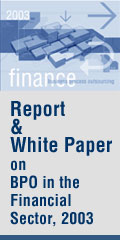|
|
Indian Banks generally resilient under stress test; Ratings mostly stable, says Fitch Ratings
01 October 2009: Fitch Ratings has today commented in a special report that the Indian banking system is expected to remain resilient even under rigorous stress assumptions on both asset quality and profitability during FY10 (financial year ended March 2010) and FY11. Fitch expects system profits at the aggregate to be able to absorb sharp increases in credit cost, leaving the aggregated capital unimpaired. Similarly, the impact of the agency's 'stress test' on 30 Indian banks (accounting for 78% of system assets) indicates that capital is protected for a majority of the banks, while some of the weaker banks would need to raise core capital in order to better prepare for the current downturn in the credit cycle.
The key elements in Fitch's simulation exercise have been the depth and pace of deterioration in performance - for example, simulating gross NPL levels to nearly 10% by March 2011 on the existing loan portfolio and measuring the impact of sharp rises in credit costs. The increase in credit costs has been based on Fitch's estimate of potential impact on the different sectors to which Indian banks are exposed, while maintaining loan loss reserves of 60% on NPLs. Under the stress test, the credit cost for the Indian banking system potentially reaches 2.28% of loans, compared with an annual average of 0.7% during FY06-FY09, with restructured loans and potential NPLs from corporate lending being the largest contributors to the stress.
Further, pre-provision operating profits are reduced by 20% from FY09 levels to reflect potential pressures on lending margins and lower trading income. Even under such fairly rigorous assumptions, the stressed operating profit of the banking system is able to absorb the increased credit costs, leaving the system's aggregate capital unimpaired. Nine banks fail the 'profit test', either through weaker margins, high restructured loans, portfolio concentrations or a combination of these. The impact of the profit shortfall on their Tier 1 capital is marginal for most, and is not crippling for any bank.
The Reserve Bank of India's (RBI) counter-cyclical policies during the credit boom in FY06-FY08, including increased general provisioning, have helped Indian banks better prepare for the downturn. For example, while specific loan loss provisions for the system are at 50% of gross NPLs, together with general provisions the ratio increases to about 72% for the system - although this would come down if adjusted for the restructured loans. The reported average Tier 1 ratio was about 9.5% at end-June 2009, mostly comprising core capital, further improving the defenses in the system.
The results support Fitch's rating stance on Indian banks. The immediate impact of a crisis in credit quality should be absorbed by pre-provision profits of most banks, and the issuer ratings for the stronger banks have therefore been largely stable as their capital is not expected to be threatened in the next 12-18 months.
Issuer ratings (mainly national ratings) for the weaker banks have however been under scrutiny in 2008 and 2009, resulting in several downgrades during this period. The pressure on banks' profits could also be a significant risk for holders of existing hybrid capital, as the deferral terms include a profit test subject to regulatory approval; global events suggest that depositor interests may obtain regulatory precedence over hybrid capital investors in a crisis. Fitch has therefore already widened its notching for national hybrid ratings in India for banks with low Individual Ratings and may, in general, review its notching policy in line with its global moves to reflect the higher risk on such instruments.
Federal Bank on watch on possible merger with Catholic Syrian Bank
Moody's places ratings of 13 banks on review
S&P revises outlook on 12 Indian banks to negative
S&P cuts India outlook to negative on unsustainable deficit
Fitch Affirms India’s Long-term foreign currency & local currency ratings
Moody's changes credit outlook for Indian banking to negative
Fitch affirms Indian Bank's ratings with long term stable outlook
India's Ratings Maintained by S&P on Growth Outlook
Tough year ahead for Asian banks as recession spreads
Outlooks on most banking systems in Asia Pacific turns negative
Greater refinancing risk for Asia-Pacific borrowers
Government measures should stabilize global banking markets
Global banking industry to see more restructuring & consolidation
Indian Banking sector challenged by domestic, not global, factors
CLICK FOR MORE FEATURES & STORIES
|
|


|


